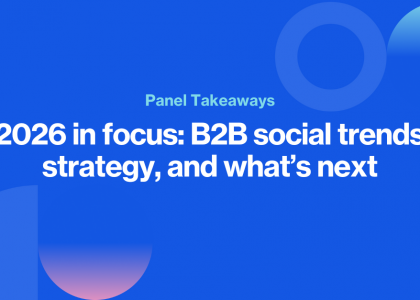Every marketing activity today, from conferences to a Google Adwords campaign, is measurable and quantifiable. Yet, most marketing leaders struggle to evaluate the channels’ effectiveness regarding social media. How much revenue has been generated from your LinkedIn posts last month? Have any of your Instagram reels brought in new customers?
83% of marketers say that social media ROI is difficult to measure. Yet, with social media being a crucial part of your marketing mix, you must be able to measure its actual value and how it contributes to your overall marketing strategy. The question is, where to begin?
To ensure you understand and measure social media data effectively, start with the basics—what it is, where to collect it, and how to use it.
What is social media data?
Social media data (or social data for short) refers to raw insights and information collected from your prospects and customers’ social media activity. It tracks how individuals engage with your content and profile on channels like LinkedIn, Facebook, and X (and yes, you should still be doing B2B marketing on X).
This data could be in the form of numbers, percentages, and statistics from which you can infer the performance of your social media strategy. For example, you can measure the number of clicks your LinkedIn posts gathered last month or your engagement rate on Facebook (the percentage of users that interacted with your content, calculated by dividing the total number of engagements by the total number of people who saw the post).
Aside from the standard metrics like shares, comments, mentions, or clicks, social media data also covers:
Engagement rate
Reach
Video views
Audience growth rate
Click-through rate (CTR)
Sentiment analysis
Profile visits
Follower demographics
Hashtag performance
Customer response rate and time
Share of voice
You can also collect data on how your audience interacts with competitors on social media, which is excellent for understanding your strengths and weaknesses.
Why do you need social media data?
If social media data are your raw ingredients, then social media analytics are your recipes. With these analytics, you can answer some critical questions about the success of your social media activities, such as:
Which networks contribute the most to lead generation?
What types of content make audiences click, share, and convert?
What are my top-converting posts?
Are audiences engaging with top-of-the-funnel (TOFU), middle-of-the-funnel (MOFU), or bottom-of-the-funnel (BOFU) content?
By answering these questions, you acquire insights or ‘social media intelligence’ to inform your decisions and actions. The raw ingredients (or social data) have been cooked into a ready-to-eat meal. As with any meal you cook, if you want it to taste good, you must use high-quality ingredients.
Focusing on simple raw data points such as likes, shares, and mentions ultimately results in a tasteless meal or meaningless insight. These so-called “vanity metrics” may look good on paper, but they won’t help you attribute social media to sales velocity and, in the end, revenue.
The only way to align social media marketing activities with business outcomes – and be able to proudly say, “LinkedIn has brought us XXX amount of customers” – is by tracking lead conversions. This will give you a complete picture of your entire buyer journey, from when a lead clicked a post to the point they converted and eventually became a customer. Without these raw data points, you wouldn’t know which lead-generation ideas to invest your resources and time.
How can I leverage social media data?
Before you keep on reading, let’s make one thing clear: social media data shouldn’t live in a silo.
Whether you’re using Google Analytics, Facebook Insights, or even your social media management platform, the most important thing about collecting social media data is leveraging it across channels, campaigns, and platforms.
Social data should transcend the borders of existing tools to benefit other departments in your organization, including sales and customer support. To get started, here are some examples of using social media data to improve your current capabilities.
Social media data for deeper audience segmentation
Everyone deserves (and expects) a custom-fit experience. Imagine an email promoting a new eBook. The nature of the email – including its tone, phrasing, and content – will differ sharply among recipients. An email written for a C-level executive will be more professional than an email written for a junior-level employee.
This is why audience segmentation is more relevant today than ever before. Most marketing automation platforms (like Marketo, Eloqua, and Pardot) will allow you to place your audiences into different “buckets” using basic parameters like geography, language preference, and business unit, where each audience member receives content relevant to their segment. So, someone living in the US will receive different content than someone living in Europe.
To take it a step further, you can use social data to segment audiences based on their social media behavior, such as the content topics or social networks they engage the most. For example, if audiences frequently click on posts about Subject A, you can strategically place them in a bucket where they will be served more content on Subject A.
Social media data for improved lead nurturing, scoring, and attribution
Most B2B companies leverage marketing automation to manage leads, nurture them with content, and deliver more sales revenue. To maximize efficiency with CRM automation, you should track and compile data from all your digital sources – from website traffic to email analytics and social media data. All the leading CRM tools will enable you to do this without operational overhead.
By feeding social media data into your marketing automation platform, you can:
Create a complete lead scoring model that includes social touches. For example, any known leads that click on a social post can be assigned a higher score than leads that click on emails.
Build a highly personalized lead nurturing system, which delivers content based on the lead’s social media activity. For example, whenever leads show high interest in a topic by frequently clicking on it, you can trigger an email campaign with content around the same subject.
Design a more accurate lead attribution model that prioritizes social media actions. Typically, if a lead converts from a webinar form, the webinar or website will receive all the credit. But what if the lead clicked on a social media post that led to the website conversion? In such a case, social media should receive the conversion credit.
Social media data for personalized sales outreach
Social media data shouldn’t be limited to B2B marketers – your sales and customer service teams can also benefit from having access to it. With this data, they can have highly personalized conversations with prospects and create materials like personalized videos for demos and tutorials.
For example, if prospect A shares your LinkedIn post about best practices for SaaS compliance, your sales rep can reach out to the prospect with a message specific to this topic. He can also send him a personalized video or email showcasing how your tool can help meet SaaS-specific regulatory requirements.
Social media data for more engaging content experiences
A content experience is the journey that your content crafts for your audience. It considers the types of content you share (UGC posts for employee advocacy, founder stories, behind-the-scenes product shots) and where and how your audience interacts with the content. For example, do they prefer to read, watch, or listen to your content? Do they interact with your content on the go or while at their desk during working hours? What channels do they prefer to consume your content?
Luckily, social media data sheds light on these behavioral insights, helping you understand your customer preferences like never before. With the help of your marketing automation tool, you can build a content experience customized to every prospect and customer. For example, suppose Katie is constantly clicking and converting from content on Topic A and Channel B. In that case, you can keep her engaged by showing her similar content in her preferred channels.
Beyond likes and shares: Using social media data for growth
Social media data is more than likes and shares. It provides B2B marketers with deeper insight into their audiences and how they engage with their company. However, you need an automated social media tool to collect and track this data across multiple channels.
Oktopost is a complete social media management platform with advanced social media analytics. This platform can provide raw data and statistical insights to help you understand the success of every post, campaign, and network. Beyond the measures of likes, shares, and impressions, Oktopost enables you to track clicks and leads from social media activities and identify which channels and messaging drive revenue for your business.
By collecting social media data with Oktopost, you can tie social media to ROI and integrate this data with your entire marketing ecosystem—including your marketing automation, CRM, and BI platforms. These powerful integrations allow you to connect the dots of your buyer journey to deliver a more engaging experience across every channel and department. Learn more here.




